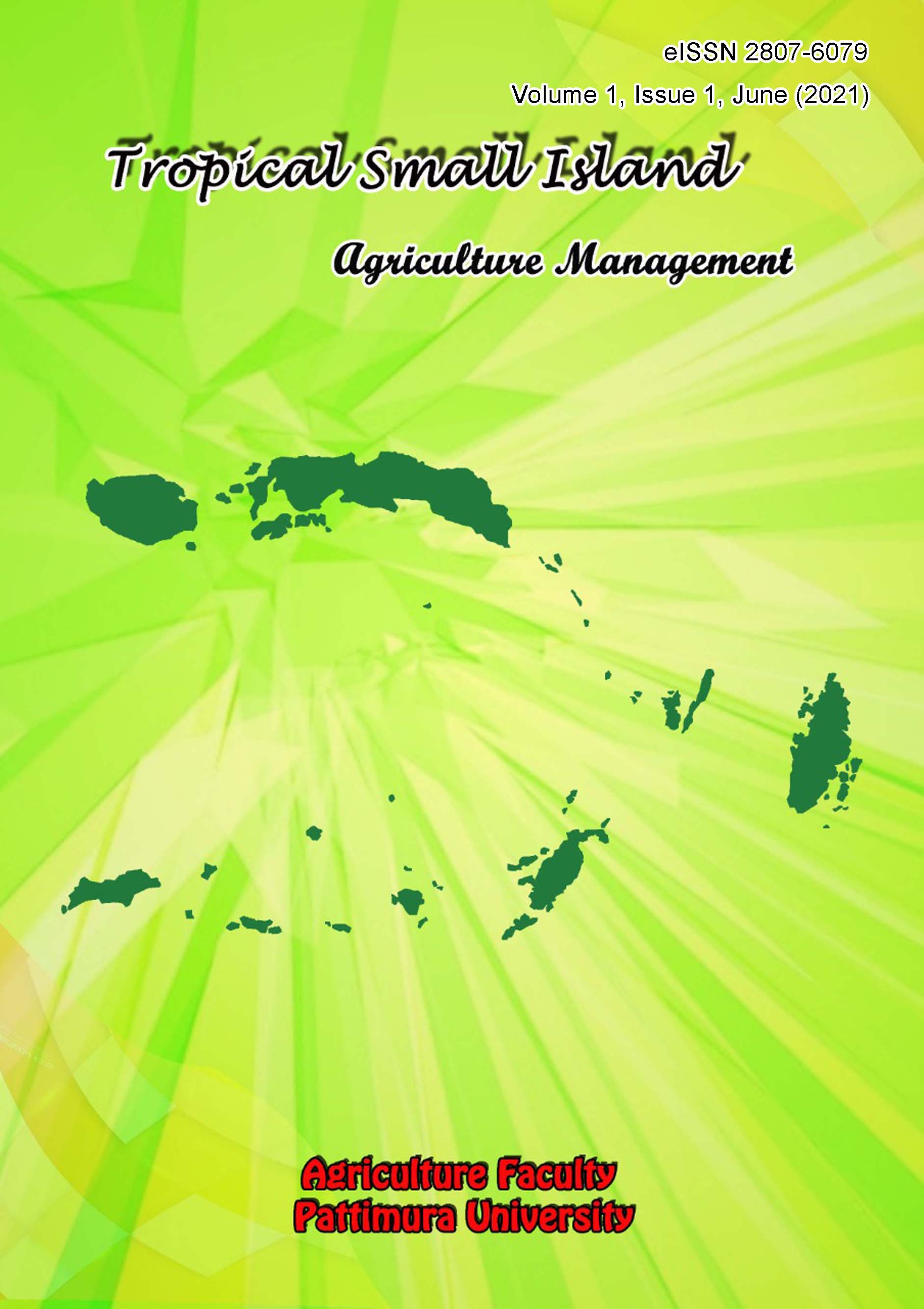Physicochemical Characteristics of Black Bean Protein Concentrate Based on the Variation of Heating Time
Abstract
One type of beans that can be used as a source of protein is the black bean (Phaseolus vulgaris. L); because it has a sufficiently high protein content of 16.6%, it has the potential to be developed into protein concentrate. This study aimed to characterize the physicochemical characteristics of black bean protein concentrate based on heating time. An experiment was carried out and arranged in a Completely Randomized Design, with four levels of treatments, i.e. heating time of 15 minutes, 30 minutes, 45 minutes, and 60 minutes. The observed variables were yield, bulk density, water absorption, protein content, moisture content, and ash content. The results showed that the yield value was 7.66 - 12.11%, bulk density 0.78 - 0.81 g/mL, water absorption 1.84 - 1.97%, protein content 71.39 - 76.00%, moisture content 11.85 - 12.94% and ash content 3.30 - 3.57%.
Downloads
References
Adhibuana, M. J., Hintono, A. and Pramono, Y. B. (2018). ‘Rendemen dan kadar protein konsentrat protein kacang tunggak (Vigna unguiculata) yang diekstraksi dengan larutan etanol dan aseton dengan konsentrasi berbeda’, Jurnal Teknologi Pangan, 2(1), pp. 17–20.
Association of Analytical Communities International. Official Methods of Analysis of AOAC. 2000. 17th ed. Gaithersburg, MD, USA: AOAC International.
do Evangelho, J. A. Berrios J. de J., Pinto V. Z., Antunes M. D., Vanier N. L., Zavarese E. da R. (2016). ‘Antioxidant activity of black bean (Phaseolus vulgaris L.) protein hydrolysates’, Food Science and Technology, 36, pp. 23–27. doi: 10.1590/1678-457X.0047.
Dunford N. T. (2012). Food and Industrial Bioproducts and Bioprocessing. Wiley-Blackwell, U.S.A
Jumanah, J., Windrati, W. S. and Maryanto, M. (2018) ‘Karakterisasi sifat fisik, kimia dan sensoris bihun berbahan tepung komposit ganyong (Canna edulis) dan kacang hijau (Vigna radiata)’, Jurnal Agroteknologi, 11(02), pp. 128. doi: 10.19184/j-agt.v11i02.6517.
MMA, M. Minka S. R., Mbome I. L., Etoa, F. X. (2011). Nutritional potential of bambara bean protein concentrate, Parkistan Journal of Nutrition, 10(2), pp. 112–119.
Okezie B. O & Bello A. B. (1988). Physicochemical and functional properties of winged bean flour and isolate compared with soy isolate. Journal Food Science, 53, 450-454. https://doi.org/10.1111/j.1365-2621.1988.tb07728.
Pazmiño, A., Vásquez, G. and Carrillo, W. (2018) ‘Pigeon pea protein concentrate (Cajanus cajan) seeds grown in Ecuador functional properties’, Asian Journal of Pharmaceutical and Clinical Research, 11(6), pp. 430–435. doi: 10.22159/ajpcr.2018.v11i6.24966.
Piñuel, L. Vilcacundo E., Boeri P., Barrio D. A., Morales D., Pinto A., Moran R., Samaniego I., Carrilo W. (2019) ‘Extraction of protein concentrate from red bean (Phaseolus vulgaris L.): Antioxidant activity and inhibition of lipid peroxidation’, Journal of Applied Pharmaceutical Science, 9(9), pp. 045–058. doi: 10.7324/JAPS.2019.90804.
Pratiwi H., Yusasrini N. L. A., Putra I. N. K. (2018). Pengaruh pH ekstraksi terhadap rendemen, sifat fisiko kimia dan fungsional konsentrat protein kacang gude (Cajanuscajan (L). Mill. sp). Jurnal ITEPA, 7(1), 1-11.
Purnomo, E. H. Ginanjar A. N., Kusnandar F., Andriani C. (2015) ‘Karakterisasi sifat fisiko-kimia tepung kacang hitam (Phaseolus vulgaris) dan aplikasinya pada brownies panggang’, Jurnal Mutu Pangan, 2(1), pp. 26–33.
Purwitasari, A., Hendrawan, Y. and Yulianingsih, R. (2014) ‘Pengaruh suhu dan waktu ekstraksi terhadap sifat fisik kimia dalam pembuatan konsentrat protein kacang komak (Lablab purpureus (L.) sweet) ’, Jurnal Bioproses Komoditas Tropis, 2(1), pp. 42–53. Available at: https://jbkt.ub.ac.id/index.php/jbkt/article/view/135.
Sosulski F. W., Garatt M. O., Slinkard A. E. (1976). Functional properties of ten legume flours. Intern Journal Food Science Technology, 9, 66–69.
Tabel Komposisi Pangan Indonesia (TKPI). (2017). Kementerian Kesehatan Republik Indonesia. Jakarta. http://www.panganku.org/id-ID/berita/20. (accessed 16 Februari 2021).
Tiwari, K., & N. Singh. (2012). Pulse Chemistry and Technology. RSC Publishing, U. K. https://pubs.rsc.org/en/content/ebook/978-1-84973-331-1.
Zar Oo, Z., Linn Ko, T. and Soe Than, S. (2017) ‘Physico-chemical properties of extracted Mung Bean protein concentrate’, American Journal of Food Science and Technology, 5(6), pp. 265–269. doi: 10.12691/ajfst-5-6-7.
Zhao, J. Liu D., Chen F., and Liu, G (2012) ‘Functional properties of sesame seed protein prepared by two different methods, Journal of Chemical Society of Pakistan 1’, 34(5), 1101-1106.
Copyright (c) 2021 Syane Palijama, Priscillia Picauly, Windarti Windarti

This work is licensed under a Creative Commons Attribution-ShareAlike 4.0 International License.
Authors who publish with this journal agree to the following terms:
- Authors retain copyright and grant the journal right of first publication with the work simultaneously licensed under a Creative Commons Attribution License that allows others to share the work with an acknowledgment of the work's authorship and initial publication in this journal.
- Authors are able to enter into separate, additional contractual arrangements for the non-exclusive distribution of the journal's published version of the work (e.g., post it to an institutional repository or publish it in a book), with an acknowledgment of its initial publication in this journal.
- Authors are permitted and encouraged to post their work online (e.g., in institutional repositories or on their website) prior to and during the submission process, as it can lead to productive exchanges, as well as earlier and greater citation of published work (See The Effect of Open Access).









